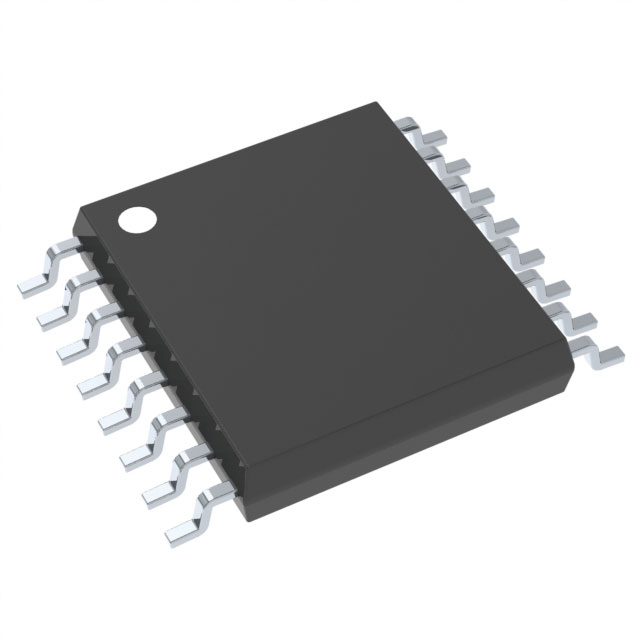Lihat spesifikasi untuk detail produk.

SN74LVC139APWE4
Product Overview
- Category: Integrated Circuit (IC)
- Use: Decoder/Demultiplexer
- Characteristics:
- Low-voltage CMOS technology
- High-speed operation
- Wide operating voltage range
- Low power consumption
- Package: TSSOP-16
- Essence: Dual 2-to-4 line decoder/demultiplexer
- Packaging/Quantity: Tape and reel, 2500 units per reel
Specifications
- Supply Voltage Range: 1.65V to 5.5V
- Input Voltage Range: 0V to VCC
- Output Voltage Range: 0V to VCC
- Operating Temperature Range: -40°C to +85°C
- Propagation Delay Time: 3.8 ns (typical)
- Maximum Quiescent Current: 10 µA
- Maximum Output Current: ±32 mA
Detailed Pin Configuration
The SN74LVC139APWE4 has a total of 16 pins, which are assigned as follows:
- A0: Address input 0
- A1: Address input 1
- GND: Ground
- Y0: Output 0
- Y1: Output 1
- Y2: Output 2
- Y3: Output 3
- G1: Enable input 1
- G2: Enable input 2
- VCC: Positive supply voltage
- B0: Address input 0
- B1: Address input 1
- GND: Ground
- Y0: Output 0
- Y1: Output 1
- Y2: Output 2
Functional Features
The SN74LVC139APWE4 is a dual 2-to-4 line decoder/demultiplexer IC. It is designed to convert binary information from two input lines (A0 and A1) into four output lines (Y0, Y1, Y2, and Y3). The enable inputs (G1 and G2) control the operation of the decoder/demultiplexer.
Advantages and Disadvantages
Advantages: - Low-voltage CMOS technology allows for compatibility with a wide range of devices - High-speed operation enables efficient data processing - Wide operating voltage range provides flexibility in various applications - Low power consumption helps conserve energy
Disadvantages: - Limited number of output lines (four) - May require additional components for complex applications
Working Principles
The SN74LVC139APWE4 operates based on the principles of digital logic. The address inputs (A0 and A1) determine which output line(s) will be activated. When the enable inputs (G1 and G2) are high, the selected output line(s) will reflect the binary information present at the address inputs.
Detailed Application Field Plans
The SN74LVC139APWE4 can be used in various applications, including but not limited to: - Address decoding in microcontrollers and microprocessors - Data routing and selection in multiplexers - Memory addressing in RAM and ROM systems - Signal demultiplexing in communication systems
Detailed and Complete Alternative Models
Some alternative models that offer similar functionality to the SN74LVC139APWE4 include: - CD74HC139E: Dual 2-to-4 line decoder/demultiplexer, DIP-16 package - 74HCT139: Dual 2-to-4 line decoder/demultiplexer, SOIC-16 package - MC14539B: Dual 2-to-4 line decoder/demultiplexer, PDIP-16 package
These alternative models can be considered based on specific requirements and compatibility with existing systems.
Word count: 346 words
Sebutkan 10 pertanyaan dan jawaban umum terkait penerapan SN74LVC139APWE4 dalam solusi teknis
Sure! Here are 10 common questions and answers related to the application of SN74LVC139APWE4:
Q: What is SN74LVC139APWE4? A: SN74LVC139APWE4 is a dual 2-to-4 line decoder/demultiplexer integrated circuit (IC) manufactured by Texas Instruments.
Q: What is the purpose of SN74LVC139APWE4? A: SN74LVC139APWE4 is used to decode binary information from two input lines into four output lines, making it useful in various digital applications.
Q: What is the voltage range supported by SN74LVC139APWE4? A: SN74LVC139APWE4 supports a wide voltage range of 1.65V to 5.5V, making it compatible with both low-voltage and standard CMOS logic levels.
Q: How many inputs does SN74LVC139APWE4 have? A: SN74LVC139APWE4 has two independent input pins, A0 and A1, which can be used to select one of the four outputs.
Q: How many outputs does SN74LVC139APWE4 have? A: SN74LVC139APWE4 has four output pins, Y0, Y1, Y2, and Y3, which provide the decoded binary information based on the input selection.
Q: Can SN74LVC139APWE4 be cascaded to increase the number of outputs? A: Yes, multiple SN74LVC139APWE4 ICs can be cascaded together to increase the number of outputs and decode larger binary numbers.
Q: What is the maximum operating frequency of SN74LVC139APWE4? A: SN74LVC139APWE4 can operate at a maximum frequency of 100 MHz, making it suitable for high-speed digital applications.
Q: Does SN74LVC139APWE4 have any built-in protection features? A: Yes, SN74LVC139APWE4 has built-in ESD (electrostatic discharge) protection on all inputs and outputs, ensuring robustness against static electricity.
Q: What is the power supply voltage required for SN74LVC139APWE4? A: SN74LVC139APWE4 requires a power supply voltage between 1.65V and 5.5V, typically supplied by a regulated DC power source.
Q: Can SN74LVC139APWE4 be used in both commercial and industrial applications? A: Yes, SN74LVC139APWE4 is designed to meet the requirements of both commercial and industrial applications, offering wide compatibility.

